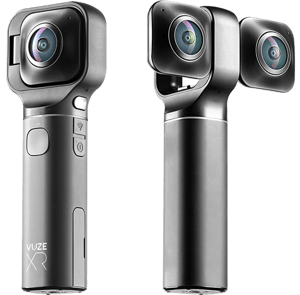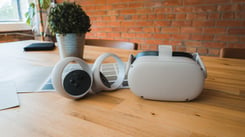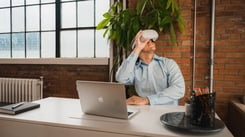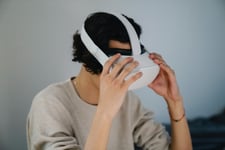Back in Spring of 2016, VR technology experienced an explosion of excited users wanting to get their hands on the VR release of the year: the Oculus Rift. After the Rift’s release, a huge wave of tech companies went to work creating video games compatible with the 360 experience.
Fast forward to today, Virtual Reality has a developed relationship with Enterprise. Numerous businesses have incorporated the advanced tech into their workflow, enhancing productivity and improving efficiency. Industries like Architecture, Engineering, and Construction (AEC) have found VR to answer many of their barriers internally and when meeting with clients. As VR continues to see mass adoption in both entertainment and business, it’s no wonder the advanced tech market is projected to be worth approximately $30 billion USD by next year.
There’s currently an overwhelming amount of information on how the VR experience is radically transformative and immersive experiences will be a game changer for the future. As a company, you may be very interested in incorporating VR into your workflow, but where do you even begin if you want to start creating your own VR content?
How to Create VR Content for Business
There are options available for anyone at any expertise level to create stunning VR content. Creating VR content is not just exclusive for those inexperienced 3D design. Let’s explore 3 different avenues at 3 levels of expertise for creating a beautiful VR project.
Level 1: No 3D Design Background
For someone who may have zero knowledge about 3D design, it can definitely be overwhelming knowing where to start. It’s important to remember that VR isn’t a piece of technology that is only exclusive for the tech fanatics. Nowadays, there are a number of options to produce a 3D scene compatible to view in VR.
We would recommend finding a 3D rendering company (like KiSP’s Visualization services) that could take your vision and turn it into (virtual) reality. Outsourcing is a great way to produce VR content if you have no background in 3D design, or especially if you’re in a pinch for time. Also, using the service is perfect for businesses that occasionally want an extra boost in a pitch. Rather than spending your time trying to figure out how to design a beautiful 3D model, outsourcing a project is an excellent choice for “one-time use”. Plus, these people are experts in what they do -- you can rest assured that they will communicate your vision into something absolutely stunning.
In the long run, it may be the most cost-effective option for producing 3D content in both time and resources. Allow the leaders in design to help you walk through the design process and take your first leap into VR.
Level 2: No Design Background but Some Experience in Tech
Another way to create content compatible to view in VR is 360-degree photography. Compared to outsourcing a VR project, 360 photography requires extra hardware, and the knowledge to use it. Although many opt to use 360 photography, one of the limitations is that you are only able to capture spaces that already exist. If that isn’t a problem for you, 360-degree photography is a great and simple way to capture a space in VR.
A 360-degree photo is a spherical panoramic image that closes in on the original point from which the photo was taken. 360-degree photos give a “human’s-eye” view of a space, allowing the viewer to experience the setting like they’re actually there. Uploading the photo to a VR viewer allows you to look up and down, left and right, or spin around in a circle to fully explore the space.
360-degree photography is quite simple and intuitive to use, however it also requires investing in the necessary hardware for a fully immersive experience. Although the overall price of the cameras has become increasingly more affordable, depending on the make and model, it can still be a heavy investment.
Here are two 360-degree camera options and different price points:
Vuze XR - $439 USD
The Vuze XR is a powerful handheld 360-degree camera that can take 18-megapixel photos or 5.7k 360 videos. This lightweight and easy to use option takes 360 content with just a simple click on a button. Additionally, their camera has 2 different mode

We have found the camera performs quite well, is very light and portable, making it convenient for on the go shooting. Although the camera is close to $500, we have found the price point is reflected in the quality it produces and it performs very well in comparison to other handheld camera options.
Insta360 Pro - $3,499 USD
The Insta360 Pro camera is definitely very pricey, however, it produces extremely high-quality 360-degree content. This camera is one of the first that performs at the calibre of a professional 360 camera yet it is very easy and intuitive to use. The camera has 8k resolution, including 360 photo and video capabilities.

At the end of the day, the Insta360 Pro is a high performing 360-degree camera. It generates extraordinary high-quality 360 content, while still being very easy to use. We personally enjoy using it when we are shooting a space for a client for the exact reason for the quality it produces. Your 360-degree content will be without a doubt remarkably stunning when using the camera.
Level 3: An Adept 3D Designer
Now heading to the most advanced option of producing VR content: designing in CAD software. Navigating through the software for a person without a background in design can be overwhelming and confusing. However, for the seasoned professional, going from a 3D model to VR content will take just one added step.
Before converting your 3D model to VR content, make sure you have at least a basic layout of a space: 4 walls, a ceiling, and a floor. Additionally, make sure to select your desired camera angles in your design.
After that, you’re ready to convert your design into a cubemap.
What is a Cubemap?
To put it simply, a cubemap is a series of six images duplicated per eye (a total of 12 images) that form the faces of a cube. The end result forms a JPEG image that you can upload to a VR viewer. Each face represents the view along the directions of the world axes. Definitely check out our knowledge base article if you would like a more in-depth look into what cubemaps are.

How Do I Create a Cubemap from my CAD Software?
A few CAD programs are capable of producing cubemaps within the software, however, CAD software like SketchUp or Rhino don’t. Nowadays, a number of VR programs have CAD plugins that will convert your 3D design into a cubemap ready to view in VR. Think of plugins like the bridge between your 3D design and Virtual Reality.
Here at Yulio, we have built plugins for SketchUp, 3DS Max, Rhino, and CET Designer. After installing your program specific plugin, you will see it appear in the toolbar of your CAD program. Select the scenes you would like to view in VR, render the cubemap, and upload it to Yulio to view it in 360.
Anyone Can Create Content for VR
We understand that diving into the world of VR content creation can be intimidating. Hopefully, walking through the different levels of content creation arms you with confidence that there are VR solutions appropriate for you. Whether you’re a professional designer or someone who’s just interested in the tech, anyone is able to create content for VR.
Here at Yulio, we strive to be the best VR presentation tool available for business. If you’re interested in learning more about our software and what we offer, please visit our page or take our product tour . To learn more about our CAD plugins, click here to download our user guides.



.jpg?width=245&height=150&name=active-adult-beautiful-1799244%20(1).jpg)



